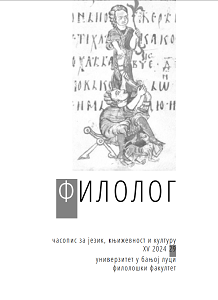ИСТОРИЈСКИ КОНТЕКСТ И ЈЕЗИЧКЕ СПЕЦИФИЧНОСТИ XXIV ЧЛАНА САЛИЈСКОГ ЗАКОНА
HISTORICAL CONTEXT AND LINGUISTIC SPECIFICITIES OF ARTICLE XXIV OF THE SALIC LAW
Author(s): Sanja M. Ljubišić, Aleksandra Kostadinović RačićSubject(s): Language studies, History of Law, Civil Law, Historical Linguistics
Published by: Филолошки факултет Универзитета у Бањој Луци
Keywords: The Salic Law; German common law; wergeld; vulgar Latin; The Malberg glosses;
Summary/Abstract: This paper explores the historical context and linguistic specificities of Article XXIV of the Salic Law, which, among other things, tells us about the killings of powerless people, in particular women and children, as well as about the type of punishment reserved for such acts. The Salic Law, one of the “most German” laws in the eyes of many, emerged in the beginning of the 6th century, and it represents a collection of common law of the Salian Franks over the course of various periods. The first two editions of the Law, the oldest ones at the same time, date back to the Merovingian dynasty, whereas the remaining editions originate in the 7th and 8th centuries. Apart from being an indispensable source to historians and jurists, the Law is equally interesting for philologists as well. The linguistic value of the Law is reflected in early features of mediaeval Latin and in non-Latin glosses distributed within the Latin text. In addition, this Law indicates some linguistic specificities of the period designated, which are reflected in certain phonetic changes, certain lexical features, and the use of archaisms. All the aforementioned provides us with an insight in the evolution of Latin and its influence on the development of Romance languages.
Journal: Филолог – часопис за језик, књижевност и културу
- Issue Year: 15/2024
- Issue No: 29
- Page Range: 67-87
- Page Count: 21
- Language: Serbian

